steering AUDI A3 2011 Owner´s Manual
[x] Cancel search | Manufacturer: AUDI, Model Year: 2011, Model line: A3, Model: AUDI A3 2011Pages: 320, PDF Size: 75.79 MB
Page 128 of 320
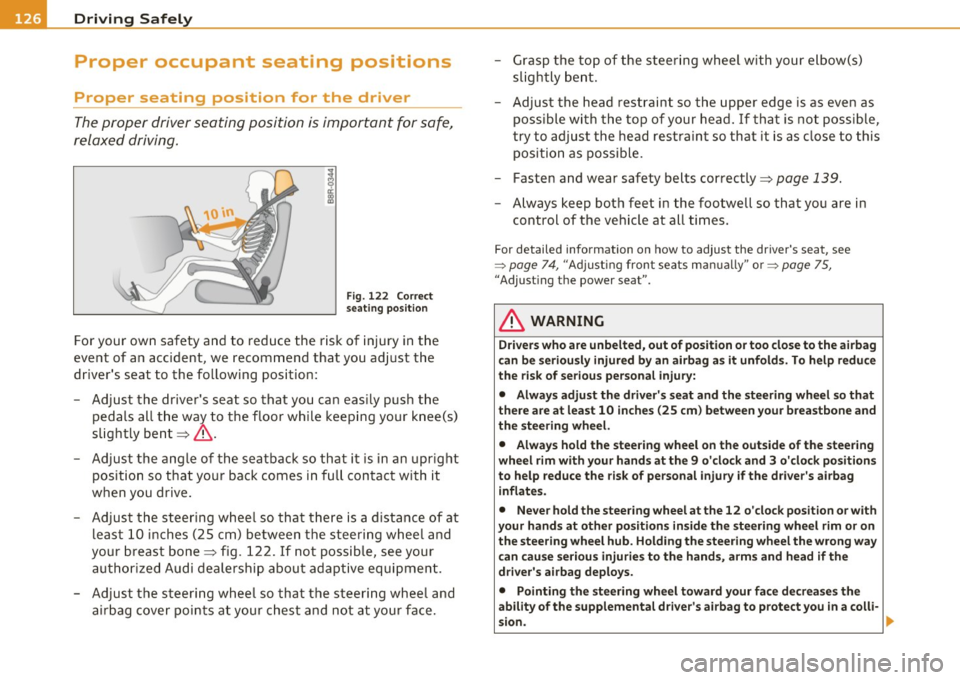
• ....__D_ r_iv _i_ n_, g=-- S_ a _ f_e _,Ly _ ______________________________________________ _
Proper occupant seating positions
Proper seating position for the driver
The proper driver seating position is important for safe,
relaxed driving.
Fig. 122 Correct
seating position
For your own safety and to reduce the risk of injury in the
event of an accident, we recommend that you adjust the
driver's seat to the following position:
- Adjust the driver's seat so that you can easily push the
pedals all the way to the floor while keeping your knee(s)
slightly bent~& .
- Adjust the angle of the seatback so that it is in an upright
pos ition so that your back comes in full contact with it
when you drive.
- Adjust the steering wheel so that there is a distance of at least 10 inches (25 cm) between the steering wheel and
your breast bone~ fig . 122. If not possible, see your
authorized Audi dealership about adaptive equipment.
- Adjust the steering wheel so that the steering wheel and airbag cover points at your chest and not at your face. -
Grasp the top of the steering wheel with your elbow(s)
slightly bent.
- Adjust the head restraint so the upper edge is as even as
possible with the top of your head. If that is not possible,
try to adjust the head restraint so that it is as close to this
position as possible.
- Fasten and wear safety belts correctly~
page 139.
-Always keep both feet in the footwell so that you are in
control of the vehicle at all t imes.
F o r deta iled informat ion on how to adjust the d river 's seat, see
=>
page 74 , "Adjusting front seats manually " or => pag e 75,
"Adjus ting the power sea t".
& WARNING
Drivers who are unbelted, out of position or too close to the airbag
can be seriously injured by an airbag as it unfolds. To help reduce
the risk of serious personal injury:
• Always adjust the driver's seat and the steering wheel so that
there are at least 10 inches (25 cm) between your breastbone and
the steering wheel.
• Always hold the steering wheel on the outside of the steering
wheel rim with your hands at the 9 o'clock and 3 o'clock positions
to help reduce the risk of personal injury if the driver's airbag
inflates.
• Never hold the steering wheel at the 12 o'clock position or with
your hands at other positions inside the steering wheel rim or on
the steering wheel hub. Holding the steering wheel the wrong way
can cause serious injuries to the hands, arms and head if the
driver's airbag deploys.
• Pointing the steering wheel toward your face decreases the
ability of the supplemental driver's airbag to protect you in a colli·
sion. .,
Page 139 of 320
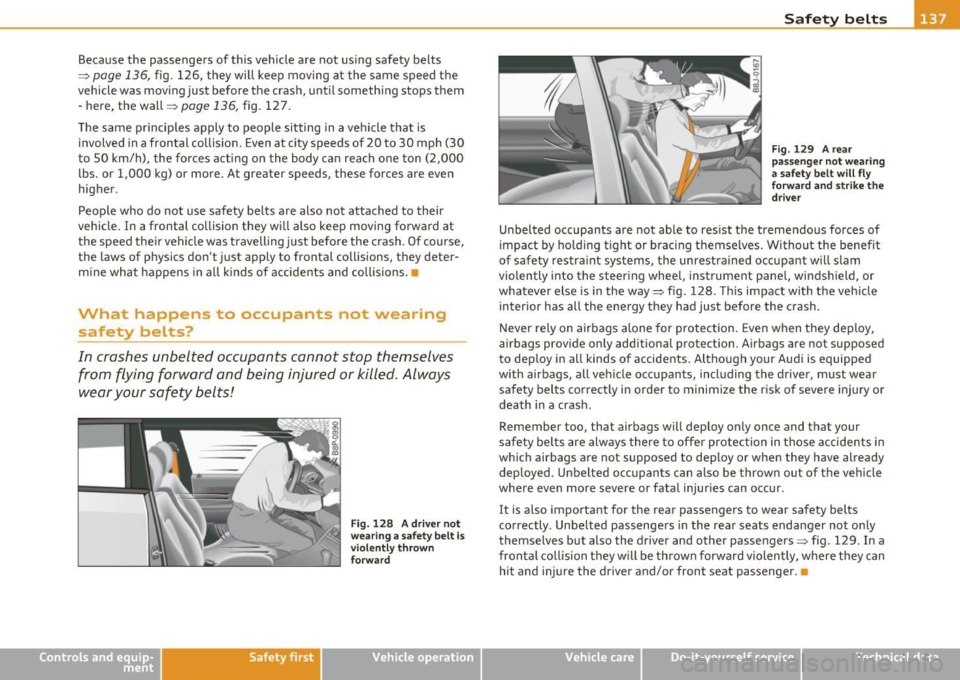
Because the passengers of this vehicle are not using safety belts
=> page 136, fig. 126, they will keep moving at the same speed the
vehicle was moving just before the crash, until something stops them
- here, the wall =>
page 136, fig. 127.
The same principles apply to people sitting in a vehicle that is
involved in a frontal collision. Even at city speeds of 20 to 30 mph (30
to SO km/h), the forces acting on the body can reach one ton (2,000
lbs. or 1,000 kg) or more. At greater speeds, these forces are even
higher .
People who do not use safety belts are also not attached to their
vehicle. In a frontal collision they will also keep moving forward at
the speed their vehicle was travelling just before the crash . Of course,
the laws of physics don't just apply to frontal collisions, they deter
mine what happens in all kinds of accidents and collisions.•
What happens to occupants not wearing
safety belts?
In crashes unbelted occupants cannot stop themselves
from flying forward and being injured or killed. Always
wear your safety belts!
Safety first
Fig. 128 A driver not
wearing a safety belt is
violently thrown
forward
Vehicle OP-eration
Safety belts
Fig. 129 A rear
passenger not wearing
a safety belt will fly
forward and strike the driver
Unbelted occupants are not able to resist the tremendous forces of
impact by holding tight or bracing themselves. Without the benefit
of safety restraint systems, the unrestrained occupant will slam
violently into the steering wheel, instrument panel, windshield, or
whatever else is in the way=> fig. 128. This impact with the vehicle
interior has all the energy they had just before the crash.
Never rely on airbags alone for protection. Even when they deploy,
airbags provide only additional protection. Airbags are not supposed
to deploy in all kinds of accidents. Although your Audi is equipped
with airbags, all vehicle occupants, including the driver, must wear safety belts correctly in order to minimize the risk of severe injury or
death in a crash.
Remember too, that airbags will deploy only once and that your
safety belts are always there to offer protection in those accidents in
which airbags are not supposed to deploy or when they have already
deployed. Unbelted occupants can also be thrown out of the vehicle
where even more severe or fatal injuries can occur.
It is also important for the rear passengers to wear safety belts
correctly. Unbelted passengers in the rear seats endanger not only
themselves but also the driver and other passengers=> fig . 129. In a
frontal collision they will be thrown forward violently, where they can
hit and injure the driver and/or front seat passenger. •
Vehicle care Do-it-yourselt service iTechnical data
Page 147 of 320
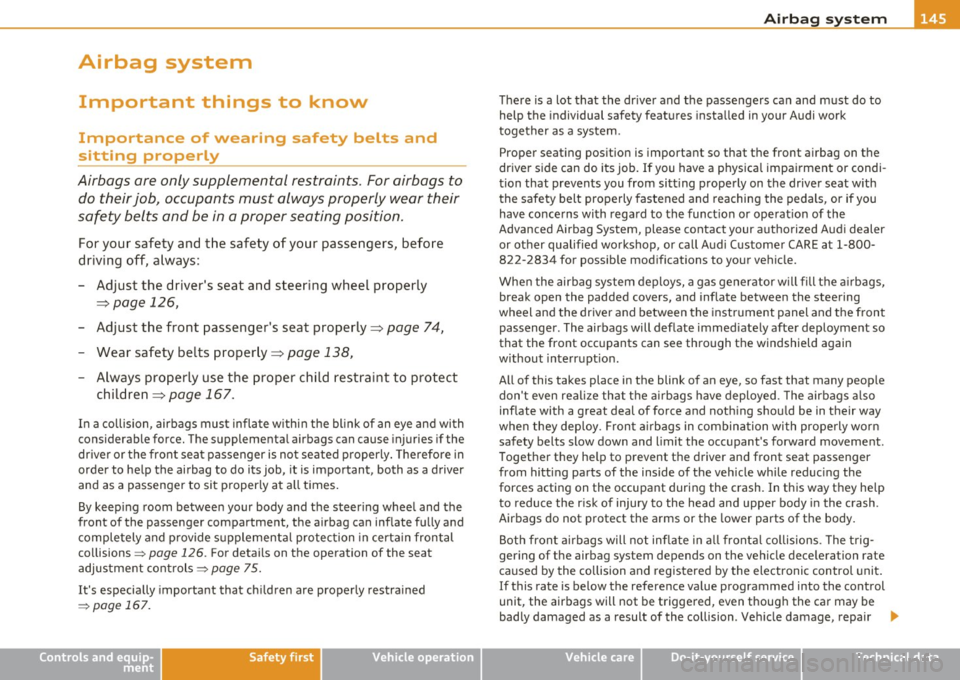
_______________________________________________ A_ ir_ b_ a_,,,g '--- s.:.y _s _t_ e _ m ___ _
Airbag system
Important things to know
Importance of wearing safety belts and
sitting properly
Airbags are only supplemental restraints. For airbags to
do their job, occupants must always properly wear their
safety belts and be in a proper seating position.
For your safety and the safety of your passengers, before
driving off, always:
- Adjust the driver's seat and steering wheel properly
=>
page 126,
- Adjust the front passenger's seat properly=> page 74,
-Wear safety belts properly=> page 138,
-Always properly use the proper child restraint to protect
children=>
page 167.
In a collision, airbags must inflate within the blink of an eye and with
considerable force. The supplemental airbags can cause injuries if the
driver or the front seat passenger is not seated properly. Therefore in
order to help the airbag to do its job, it is important, both as a driver
and as a passenger to sit properly at all times.
By keeping room between your body and the steering wheel and the
front of the passenger compartment, the airbag can inflate fully and
completely and provide supplemental protection in certain frontal
collisions =:,
page 126. For details on the operation of the seat
adjustment controls=>
page 75.
It 's especially important that children are properly restrained
=:,
page 167.
Controls and equip ment Safety first Vehicle operation
There
is a lot that the driver and the passengers can and must do to
help the individual safety features installed in your Audi work
together as a system .
Proper seating position is important so that the front airbag on the
driver side can do its job. If you have a physical impairment or condi
tion that prevents you from sitting properly on the driver seat with
the safety belt properly fastened and reaching the pedals, or if you
have concerns with regard to the function or operation of the
Advanced Airbag System, please contact your authorized Audi dealer
or other qualified workshop , or call Audi Customer CARE at 1-800-
822-2834 for possible modifications to your vehicle.
When the airbag system deploys, a gas generator will fill the airbags,
break open the padded covers, and inflate between the steering
wheel and the driver and between the instrument panel and the front
passenger . The airbags will deflate immediately after deployment so
that the front occupants can see through the windshield again
without interruption.
All of this takes place in the blink of an eye, so fast that many people don't even realize that the airbags have deployed . The airbags also
inflate with a great deal of force and nothing should be in their way
when they deploy . Front airbags in combination with properly worn
safety belts slow down and limit the occupant's forward movement .
Together they help to prevent the driver and front seat passenger
from hitting parts of the inside of the vehicle while reducing the
forces acting on the occupant during the crash. In this way they help to reduce the risk of injury to the head and upper body in the crash .
Airbags do not protect the arms or the lower parts of the body.
Both front airbags will not inflate in all frontal collisions . The trig
gering of the airbag system depends on the vehicle deceleration rate
caused by the collision and registered by the electronic control unit.
If this rate is below the reference value programmed into the control
unit, the airbags will not be triggered, even though the car may be
badly damaged as a result of the collision . Vehicle damage, repair
9J),
Vehicle care Do-it-yourself service Technical data
Page 148 of 320

1111 ....... _A_ i_rb _ a_,g,:;._ s_, y'- s_ t_e _m ________________________________________________ _
costs o r ev en t he lack of v ehicle da mage is no t necessar ily an ind ica
t ion of whe the r an a irbag should inflat e or not.
S ince th e cir cums tances will vary cons idera bly betw een one co llision
and another, it is not possible to define a range o f vehicle spee ds that
w ill co ver eve ry p oss ible kin d and a ngle o f im pact th at w ill alw ay s
tri gg er the a irba gs. Im portant facto rs inclu de, for examp le, the
n at ure (h ard or s oft) of th e obje ct whi ch th e c ar hits , th e ang le of
impact, vehicle speed, etc. The front air bags will also not inflate in
s ide or r ear coll isions , or in roll-ove rs.
Always remember: Airbags w ill deploy only once, an d on ly in certa in
kinds of co llisio ns. Your safety be lts are a lways there to offer protec
t ion in those s ituatio ns in which airbags ar e no t sup pose d to d eploy,
or w hen they have alrea dy de ploye d; for examp le, when your ve hicl e
st rike s or is st ruc k b y ano ther veh icle a fter t he first collision .
T hi s is just one of the reasons w hy an airbag is a s upplementa ry
restra in t a nd is no t a su bst itute for a safe ty bel t. Th e air bag sy stem
works most effectively when used with the safety be lts . Therefore,
always p rope rly wear y ou r safety belts => page 135 .
& WARNING
Sitting too close to the steering wheel or instrument panel will
decrease the effectiveness of the airbags and will increase the risk
of personal injury in a collision.
• Never sit closer than 10 inches (25 cm) to the steering wheel or
instrument panel.
• If you cannot sit more than 10 inches (25 cm) from the
steering wheel, investigate whether adaptive equipment may be
available to help you reach the pedals and increase your seating
distance from the steering wheel.
• If you are unrestrained, leaning forward, sitting sideways or
out of position in any way , your risk of injury is much higher.
• You will also receive serious injuries and could even be killed if
you are up against the airbag or too close to it when it inflates - even with an Advanced Airbag.
& WARNING (co ntinued )
• To reduce the risk of injury when an airbag inflates, always
wear safety belts properly=>
page 139, "Safety belts ".
• Always make certain that children age 12 or younger always
ride in the rear seat. If children are not properly restrained, they
may be severely injured or killed when an airbag infl ates .
• Never let children ride unrestrained or improperly restrained in
the vehicle. Adjust the front seats properly.
• Never ride with the backrest reclined.
• Always sit as far as possible from the steering wheel or the
instrument panel =>
page 126.
• Always sit upright with your back against the backrest of your
seat.
• Never place your feet on the instrument panel or on the seat.
Always keep both feet on the floor in front of the seat to help
prevent seriou s injuries to the legs and hips if the airbag inflates.
• Never recline the front passenger's seat to transport objects .
Items can also move into the area of the side airbag or the front
airbag during braking or in a sudden maneuver. Objects near the
airbags can become projectiles and cause injury when an airbag inflates .
& WARNING
Airbags that have deployed in a crash must be replaced .
• Use only original equipment airbags approved by Audi and
installed by a trained technician who has the neces sary tools and
diagnostic equipment to properly replace any airbag in your
vehicle and assure system effectiveness in a crash.
• Never permit salvaged or recycled a irbags to be installed in
your vehicle. •
Page 151 of 320
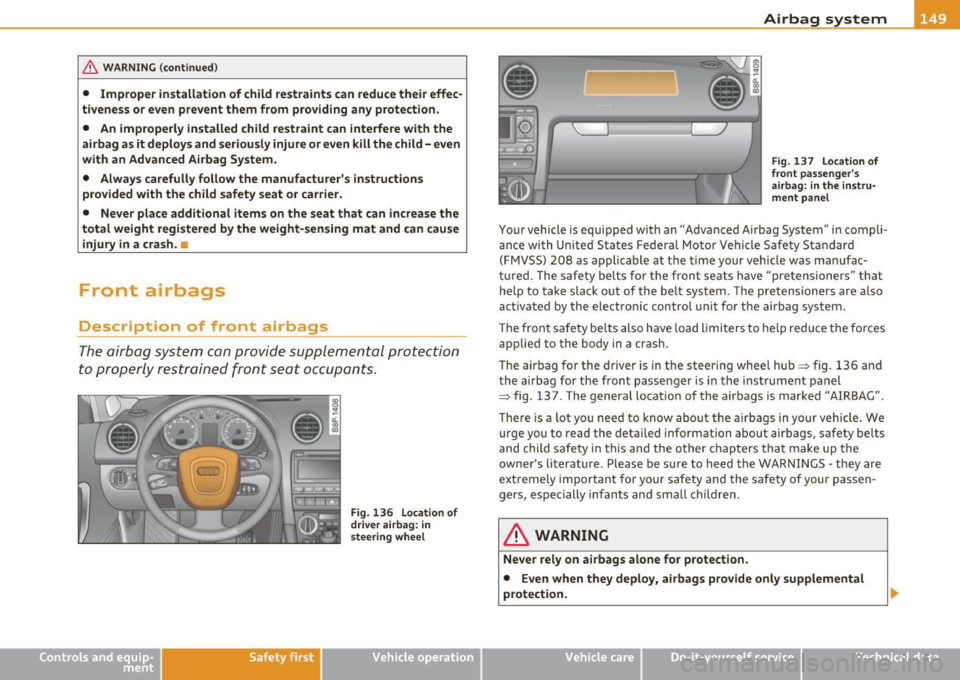
& WARNIN G (con tinued )
• Imprope r in stall ation of child re straints can redu ce their effec·
tiveness or even prevent them from providing any protection.
• An improperl y installed child restraint c an interfere with the
airbag a s it deploy s and seriously injure or even kill the child - even
with an Advanced Airbag Sy stem.
• Always carefully follow the manufacturer 's instruct ions
provided with the child safety seat or carrier.
• Never place additional items on the seat that can increase the
total weight regi stered by the weight-sen sing mat and can cause
injury in a crash .•
Front airbags
Description of front airbags
T he airbag system can p rovide supplemental protection
to properly r estrained front se at oc cupants .
Safety first
Fig . 136 Locatio n of
drive r airb ag : in
s tee ring whee l
Vehicle OP-eration
'l
-- -
Airbag system
Fig . 1 37 Locati on of
fr on t pass enge r's
a ir bag: in the instru
me nt pa nel
Yo ur vehicle is equi pped with an "Advanced A irbag Syst em" in compli
ance with United States Fe dera l Moto r Vehicle Safety Sta ndard
(FMVSS) 2 08 as a pplicable at t he time your vehi cle was manufac
t u red . The safety belts fo r th e front seats have "p retensioners" t hat
help to ta ke slack out of the bel t sy ste m. The pre tension ers are also
act ivated by the electronic control unit for the airbag system .
Th e front sa fe ty bel ts also have lo ad limi ters to help red uce the fo rces
applied to the body in a crash.
Th e airbag for the driver is in t he steering whee l hub ~ fig .
136 and
t h e airbag for th e front pass enger is i n the inst rum ent pa nel
~ fig. 13 7 . The general locat ion of the airbags is marked "AIRBAG".
Th ere is a lo t you nee d to know abo ut the air bags in your vehicle. We
urge yo u to read the detai led information about airbags , safety be lts
and c hild s afety in this and the other chap ters that make up the
own er's literature. Please be sure to heed the WAR NIN GS· they are
extremely importan t for your safety an d the sa fe ty of your p asse n
gers, es pecially infants a nd sma ll ch ildre n.
& WARNING
Never rely on airbags alone for protection.
• Even when they deploy, airbags provide only supplemental
protection.
Vehicle care Do-it-yourselt service iTechnical data
Page 152 of 320

........ _A_ i_rb _ a_,g,:;._ s_, y'- s_ t_e _m ________________________________________________ _
& WARNING (conti nued)
• Airbag work mo st effectivel y when us ed with p roperly worn
safety belts .
• Therefore, always wear your safety belts and make sure that
everybody in your veh icle is properly restrained .
& WARNING
A person on the front passenger seat , especially infants and small
c hildren, will receive seriou s injuries and can even be killed by
being too close to the a irbag when it inflates.
• Although the Advanced Airbag System in your vehicle is
designed to turn off the front passenger a irbag if an infant or a
small child is on the front passenger seat, nobody can absolutely
guarantee that deployment under these special conditions is
impossible in all conceivable situations that may happen during
the useful life of your vehicle.
• The Advanced Airbag System can deploy in a ccordance with the
" low risk" option under the U.S. Federal Standard if a child that is
hea vier than the t ypical one-year old child is on the front
passeng er seat and the other condition s for airbag deployment
are met.
• Accident statistics have shown that children are generally safer
in the rear seat area than in the front seating position .
• For their own safety, all children , especially 12 years and
younger, should always ride in the back properly res trained for
their age and size. •
Advanced front airbag system
Your vehicle is equipped with a front Advanced Airbag System in
compliance wit h Unit ed St ates Fe d er al Motor Vehi cle Safe ty Standar d
208 as applicab le at the time your vehicle was manufactured . The front Advanced A
irbag System supplements the safety belts to
prov ide ad ditional prote ct ion for th e d river's and front passenger's
heads and uppe r bodies in fro nta l crashes. The ai rbags i nflate only in
fronta l impacts when the vehicle dece leration is high enoug h.
Th e front Adva nced A irbag Sys tem for the fron t seat oc cupan ts is not
a s ubstitute for your safety be lts. Rathe r, it is part o f the overall occu
p an t restr aint sy stem in y our ve hicl e. Always remembe r that the
airbag system ca n only help to protect you, if you are sitting upr ight,
we aring your sa fe ty be lt and we aring it prope rly. T his is why you and
your passengers must always be properly restra ined, not just because
t he law requires you to be.
Th e A dvan ced A irbag Syst em in your veh icle has been c ertified to
meet the "low r isk" req uir ements fo r 3 an d 6 year-old c hildren on the
pas senge r side and ve ry small ad ults o n the dr ive r side. T he low r is k
dep loyment cr iteria a re intended to help reduce the risk of injury
t hroug h in teraction wi th the front a irbag tha t can oc cur, fo r ex am ple,
by being too close to the steering wheel and instrument panel whe n
t he air bag i nflates .
In add it ion , the system has been cert ified to comply with t he
"supp ression" requirements of the Safety Standa rd, to t urn off the
front airbag for infants 12 mont hs old and young er w ho are
restrained on the front passenger seat in child restra ints that are
listed in the Standard=>
pag e 169 .
"Suppression" requires the front airbag on the passenger side to be
tur ned off if :
• a ch ild up to about one yea r of age is restra ined on the fron t
passenge r seat in one o f th e rear -facing or forward- facing infant
restraints listed in Federa l Motor Vehicle Saf ety St andar d 208 w it h
w hich the Advanced A irbag System in yo ur vehicle was ce rtif ied. Fo r a
lis ting of the chil d res trai nt s t hat were u sed to certify your vehicle' s
compliance with the US Safety Standard =>
page 169,
• weigh t less t han a thres ho ld level stored in the cont ro l un it is
detected on the front passenger seat.
W hen a perso n is de te cte d on t he fro nt pas senger se at, weigh ing
more than the tota l weight of a child that is about 1 year o ld
Page 161 of 320
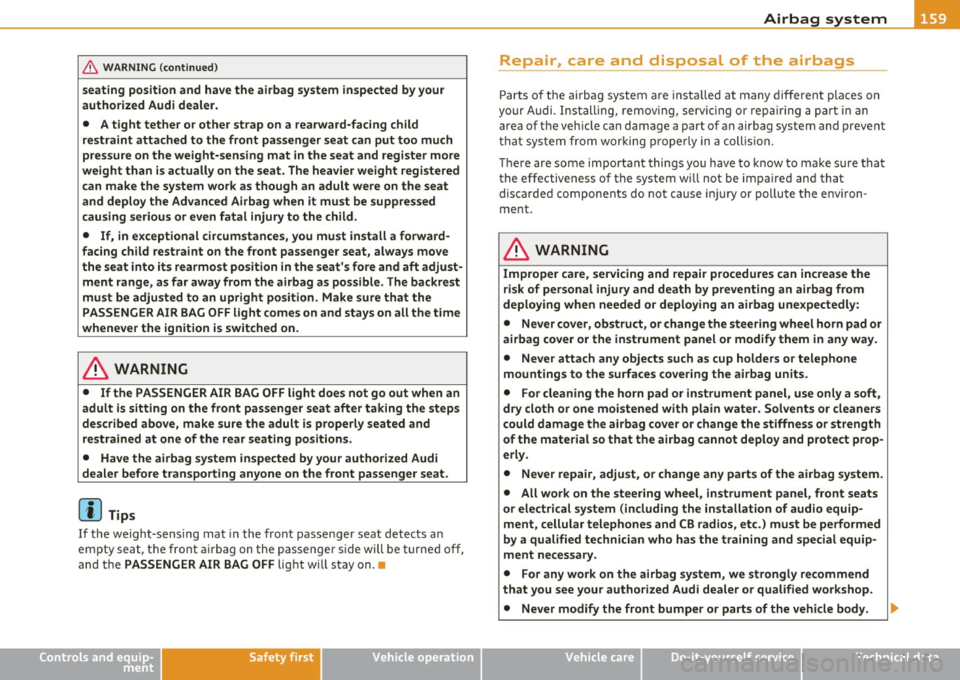
_______________________________________________ A_ ir_ b_ a_,,,g '--- s.:.y _s _t_ e _ m ___ _
& WARNING (co ntinued )
seating position and have the airbag system inspected by your
authorized Audi dealer.
• A tight tether o r other strap on a rearward -facing child
restraint attached to the front pa ssenger seat can put too much
pressure on the weight -sensing mat in the seat and register more
weight than i s actually on the seat . The heavier weight regi stered
can make the system work as though an adult were on the seat
and deploy the Advan ced Airbag when it mu st be suppre ssed
causing serious or even fatal injury to the child .
• If , in exceptional circumstanc es, you must install a forward
facing child restraint on the front passenger seat, always move
the seat into its rearmost po sition in the seat' s fore and aft adjust
ment range, as far away from the airbag as possible . The backrest
must be adjusted to an upright position. Make sure that the PASSENGER AIR BAG OFF light comes on and stays on all the time
whenever the ignition is switched on.
& WARNING
• If the PASSENGER AIR BAG OFF light doe s not go out when an
adult is sitting on the front passenger seat after taking the steps
described above, make sure the adult is properly seated and
restrained at one of the rear seating positions.
• Have the airbag system inspected by your authorized Audi
dealer before transporting anyone on the front passenger seat .
[ i ] Tips
If the we ight-sensing mat in the front passenger seat detects an
em pty seat , the front airbag on the passenge r side will be t urne d off,
and the PASSENGER AIR BAG OFF light will stay on .•
Controls and equip ment Safety first Vehicle operation
Repair, care and disposal of the airbags
Parts of the airbag system are
insta lled at many different places on
your Audi . Ins tall ing, remov ing, serv icing o r rep airi ng a pa rt in an
area of the vehicle ca n damage a part of a n airbag system and prevent
t ha t sys tem from working prope rly in a coll is io n.
Th ere are some importa nt things you have to know to ma ke sure t hat
the effectiveness of the system will not be impai red and that
dis ca rded compo nents do not cause injury or po llute t he e nvir on
ment .
& WARNING
Improper care , serv icing and repair procedures can increase the
risk of personal injury and death by preventing an airbag from
deploying when needed or deploying an airbag unexpectedly:
• Never cover, obstruct, or change the steering wheel horn pad or
airbag cover or the instrument panel or modify them in any way .
• Never attach any objects such as cup holders or telephone
mountings to the surfaces covering the airbag units.
• For cleaning the horn pad or instrument panel, use only a soft ,
dry cloth or one moistened with plain water . Solvent s or cleaners
could damage the airbag cover or change the stiffness or strength
of the material so that the airbag cannot deploy and protect prop
erly.
• Never repair, adjust, or change any part s of the airbag system .
• All work on the steering wheel, instrument panel , front seats
or electrical sy stem (including the installation of audio equip
ment, cellular telephones and CB radios, etc. ) must be performed
by a qualified technician who has the training and special equip ment necessary .
• For any work on the airbag system, we strongly recommend
that you see your authorized Audi dealer or qualified workshop.
• Never modify the front bumper or parts of the vehicle body . ..,_
Vehicle care Do-it-yourself service Technical data
Page 190 of 320

Intelligent technology
'-----------------------------------------------
Intelligent technology
Notice about data recorded by
vehicle control modules
Your vehicle is not equipped with an Event Data Recorder (EDR),
installed by some manufacturers for the express purpose of
capturing data for retrieva l after an accident or crash event. ED R's are
sometimes called "crash recorders".
Some state laws restrict the retrieval or downloading of data stored
by ED R's that were installed in a vehicle for the express purpose of
retrieving data after an accident or crash event without the owner's
consent.
Although your vehicle is not equipped with an EDR, it is equipped w ith
a number of electronic control modu les for various vehicle systems
such as, for example, engine function, emission control, as well as for
the airbags and safety belts.
T hese electronic contro l modules also record vehicle-re lated data
during normal vehicle operation for diagnostic and repair purposes .
Th e recording capacity of the e lectronic control modu les is limited to
data (no sound is recorded) and only a sma ll amount of data is actu
ally recorded over a very limited period of time and stored when a
system fault or other condition is sensed by a control unit. Some of
the data then stored may relate to vehicle speed, direction, braking
as well as restraint system use and performance in the event of a
crash or other condition. Stored data can only be read and down
loaded with special equipment.
Electronic Stabilization Program
(ESP)
General
The Electronic Stability Program increases driving
stability .
With ESP, contro l over the vehicle is increased in situations when the
vehicle is close to the limits of grip, such as dur ing accelerat ion and in
curves. ESP reduces the risk of sk idding and improves vehicle stability
unde r all road conditions.
It operates at all speeds.
The Anti-Lock Brake System (ABS), Electronic Differential Lock (EDS) and Anti-Slip Regulation System (ASR) are integrated in the Elec
tronic Stability Program .
How ESP works
The ESP control unit processes the following data from high-sensitive
sensors: the rotationa l speed of the vehicle about its vertical axis,
fore-and -aft and lateral acceleration forces, brake pressure and
steering angle .
Us ing stee ring ang le and vehicle speed, the direction the driver
wishes to travel is determined and continuously compared with
actual vehicle behavior. If the two do not match, for example when
the vehicle beg ins to skid, ESP brakes the appropriate whee l auto
matically.
The vehicle is stabilized aga in by the forces act ing on the whee l
during braking. With an oversteering veh icle (tendency for the rear
end to skid out of the curve), the brake app lication is mainly at the
front wheel on the outside of the curve, with an understeering vehicle
(tendency to run wide in the curve) at the rear wheel on the insid e of
the curve or additionally at the other wheels as needed. This brake
application is accompanied by noises. _,
Page 195 of 320
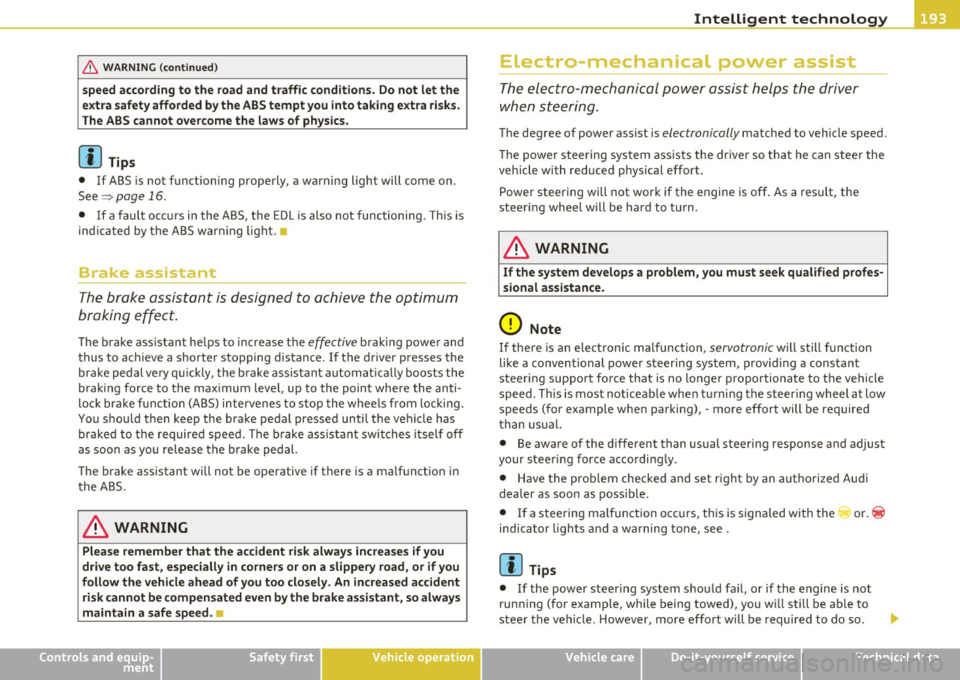
Intelligent technologyz..__~~-____________________________ __.
& WA RNING (c on tinued )
speed acco rding to the road and traffic conditions. Do not let the
e xtra safety afforded by th e ABS tempt you into taking extra risk s.
The ABS cannot overcome the laws of physics .
[ i J Tips
• If ABS is not funct ioning properly, a warning light will come on .
See ~
page 16 .
• If a fault occurs in the ABS, the EDL is also not functioning. This is
ind ic at ed by t he A BS w arni ng light. •
Brake assistant
The broke assistant is designed to achieve the optimum
br oking effect.
Th e b rake ass istant he lps to inc rease t he effective brak ing powe r and
thus to ac hieve a shorter stopping distance.
If the driver presses the
bra ke ped al ve ry qu ickly, the b rake assistant au toma tically bo osts the
brak ing force to the max imum level, up to the point where the anti
lo ck brak e function (ABS) in tervenes to stop the whee ls from l ocking.
You should then keep the brake pedal pressed unti l the vehicle has
bra ke d to t he require d spee d. T he bra ke ass istan t swi tches itse lf off
as soon as you re lease the b rake pedal.
Th e brake assistant will not be operative if there is a ma lfu nctio n in
t he A BS .
& WARNING
Please remember that the accident risk always increases if you
drive too fast , especially in corners or on a slippery road , or if you
follow th e vehicle ahead of you too closely. An increased accident
risk cannot be compensated even by the brake assistant, so always
maintain a safe speed .•
Controls and equip ment Safety first Vehicle operation
Electro-mechanical power assist
---
T
he elec tro-m echa nic al po wer as sist hel ps the dri ver
w he n steering .
The degree of power assist is electronically matched to vehicle speed.
Th e powe r steering system ass ists the dr iver so t hat he ca n stee r the
vehicle with reduced physical effort.
Power steering will not wor k if the engine is off. As a result, the
stee rin g wheel will b e ha rd to tu rn .
& WARNING
If the system deve lops a problem, you must seek qualified profes
sional as sistance.
0 Note
If the re is an elect ronic mal func tion, servotronic will s till f unction
li ke a conven tional power steering system, p rovid ing a constant
steering support fo rce that is no longer proportionate to the ve hicle
spee d. This is most noticeab le whe n tur ning the s teer ing whe el at low
speeds ( for example when park ing), -more effort will be required
t h a n usual.
• Be aware o f the d ifferent than usual steering response and adjust
your st eering force a ccordi ng ly.
• Have the prob lem checked and set r ight by an autho rize d Aud i
dealer as soo n as possib le.
• If a steering ma lf u nction occ urs, t his is signaled w ith the or. ~
indicator l igh ts a nd a wa rning tone, see .
[I] Tips
• If the powe r stee ring system shou ld fa il, or if the engine is not
run ning (for example, while being towed), you w ill still be ab le to
stee r the veh icle. However, more effort wi ll be required to do so . .,.
Vehicle care Do-it-yourself service Technical data
Page 196 of 320
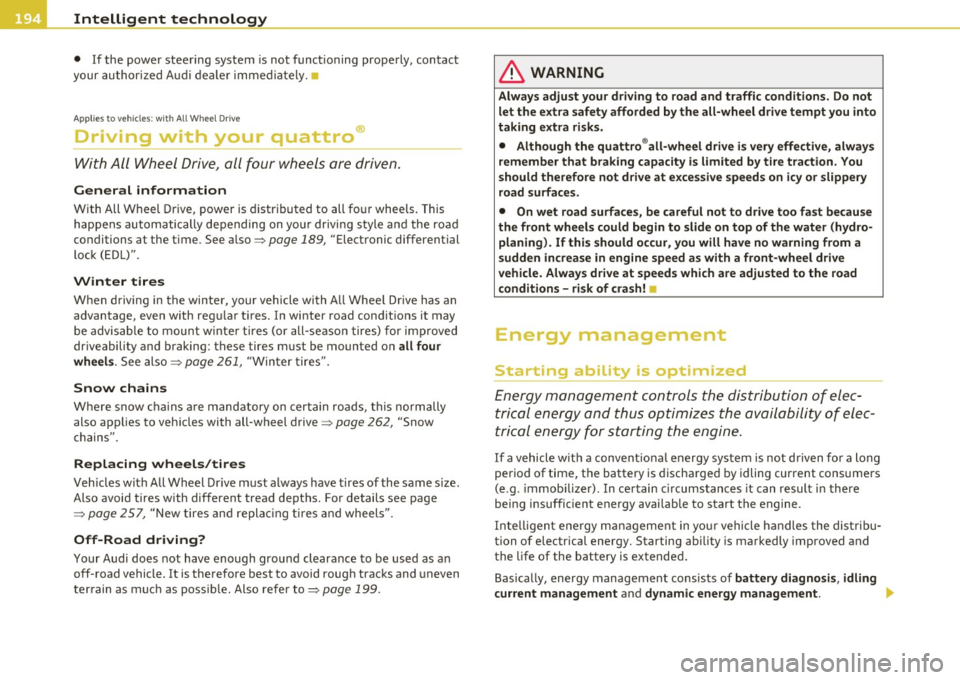
Intelligent technologyL _______________________________________ _
• If the power steering system is not funct ioning properly, contact
your au thori zed A ud i dea le r i mmediately. •
Applies to ve hicl es: wit h A ll Whe el D rive
Driving with your quattro®
With All Wheel Drive, all four wheels are driven.
General information
With All Wheel Drive, power is distributed to all fo ur whee ls. This
happens automatically depending on you r driving s tyle a nd the road
conditions at the time. See also =>
page 189, "Electronic differential
lo ck (E DL)".
W inter tires
W hen d riving in the winter, your vehicle with A ll Whee l Drive has an
advantage, even with reg ular t ires . In winter road cond it ions it may
be advisab le to mou nt w inte r ti res (or all-se aso n t ires) for imp roved
dr iveability and braking: these tires must be mounted on
all four
wheel s.
See also => page 261, "Win ter tires".
Snow chains
W he re snow c ha ins are mand atory on certain roads, this norm ally
also app lies to veh icles with all-wheel drive=>
page 262, "Snow
c hains".
Replacing wheels/tires
Veh icles with All Wheel Drive m ust always have t ires of the same s ize.
Also avoid tires with different tread depths. For details see page
=>
page 257, " N ew tires and replac ing ti res and wheels".
Off-Road driving?
Your Audi does not have enough ground clearance to be used as a n
off-road vehicle. It is therefore best to avoid rough tracks and uneven
te rrain as much as poss ib le. Also refe r to=>
page 199.
& WARNING
Always adjust your driving to road and traffic conditions . Do not
let the extra safety afforded by the all-wheel drive tempt you into
taking extra risk s.
• Although the quattro ®all -wheel drive is very effective, always
remember that braking capacity is limited by t ire traction. You
should therefore not drive at exce ssive speed s on icy or slippery
road surfaces .
• On wet road surfa ces, be careful not to drive too fast becau se
the front wheels could begin to slide on top of the water (hydro
planing ). If this should occur, you will have no warning from a
sudden increase in engine speed as with a front -wheel drive
vehicle. Always dr ive at speed s which are adjusted to the road
conditions -risk of crash! •
Energy management
Starting ability is optimized
Energy managemen t controls the distribution of elec
trical energy and thus optimizes the availability of elec
t r ical ene rgy for s tarting the en gin e.
If a vehicle w ith a convent ional energy sys tem is not d riven fo r a long
period of time, t he battery is discha rged by idling cur rent consumers
(e .g. immob ilizer). In ce rtain c ircumstances it can result i n there
being insufficient energy availab le to start the engine .
Inte lligent ene rgy m anageme nt in yo ur vehicle h andles the dis tribu
tion of electrical energy. Starting ability is markedly improved and
t he life of the bat tery is ex tende d.
Bas ically, energy management consis ts of
battery d iagnosis, idling
current management
and dynamic energy management . ~